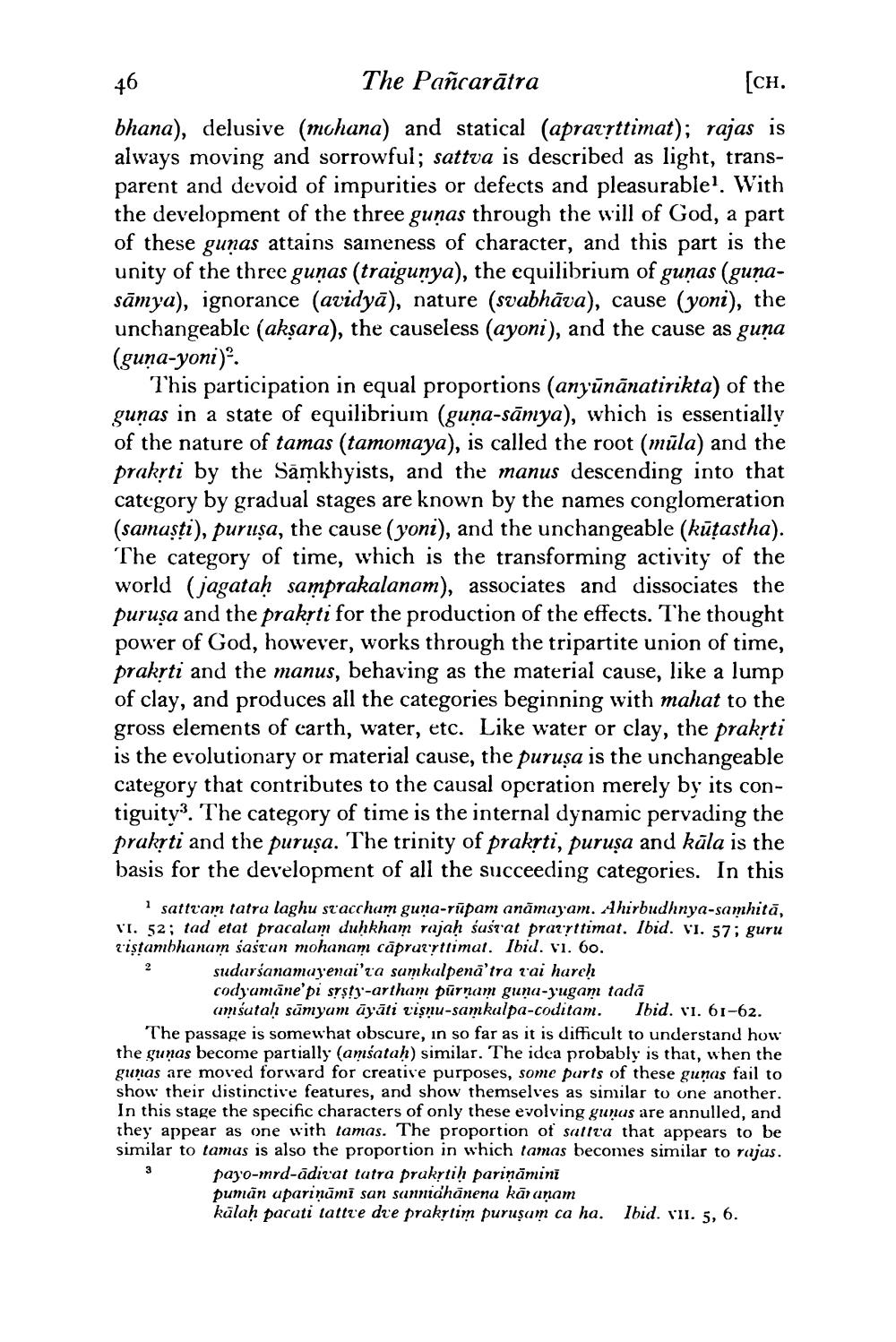________________
46
The Pañcaratra
[CH.
bhana), delusive (mohana) and statical (apravṛttimat); rajas is always moving and sorrowful; sattva is described as light, transparent and devoid of impurities or defects and pleasurable1. With the development of the three guṇas through the will of God, a part of these gunas attains sameness of character, and this part is the unity of the three gunas (traigunya), the equilibrium of gunas (gunasāmya), ignorance (avidyā), nature (svabhāva), cause (yoni), the unchangeable (akṣara), the causeless (ayoni), and the cause as guna (guna-yoni).
This participation in equal proportions (anyūnānatirikta) of the gunas in a state of equilibrium (guṇa-sāmya), which is essentially of the nature of tamas (tamomaya), is called the root (mūla) and the prakrti by the Samkhyists, and the manus descending into that category by gradual stages are known by the names conglomeration (samasti), puruşa, the cause (yoni), and the unchangeable (kūṭastha). The category of time, which is the transforming activity of the world (jagataḥ samprakalanam), associates and dissociates the puruşa and the prakṛti for the production of the effects. The thought power of God, however, works through the tripartite union of time, prakṛti and the manus, behaving as the material cause, like a lump of clay, and produces all the categories beginning with mahat to the gross elements of earth, water, etc. Like water or clay, the prakṛti is the evolutionary or material cause, the purusa is the unchangeable category that contributes to the causal operation merely by its contiguity. The category of time is the internal dynamic pervading the prakrti and the purușa. The trinity of prakṛti, puruşa and kāla is the basis for the development of all the succeeding categories. In this
1 sattvam tatra laghu svacchum guṇa-rūpam anāmayam. Ahirbudhnya-samhitā, VI. 52; tad etat pracalam duḥkham rajaḥ śasvat pravṛttimat. Ibid. VI. 57; guru viṣṭambhanam sasvan mohanam capravṛttimat. Ibid. vi. 60.
sudarśanamayenai'va samkalpena'tra vai hareh
codyamane' pi srsty-artham pūrṇam guna-yugam tadā amsataḥ samyam āyāti viṣṇu-samkalpa-coditam.
Ibid. VI. 61-62.
The passage is somewhat obscure, in so far as it is difficult to understand how the gunas become partially (amsataḥ) similar. The idea probably is that, when the gunas are moved forward for creative purposes, some parts of these gunas fail to show their distinctive features, and show themselves as similar to one another. In this stage the specific characters of only these evolving gunas are annulled, and they appear as one with tamas. The proportion of sattva that appears to be similar to tamas is also the proportion in which tamas becomes similar to rajas.
3
payo-mrd-adivat tatra prakṛtiḥ pariņāminī
puman upariņāmī san sannidhanena kāraṇam
kalaḥ pacati tattve dve prakṛtim puruşam ca ha. Ibid. vII. 5, 6.




